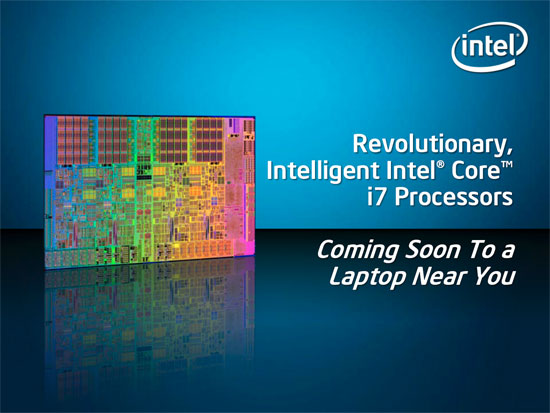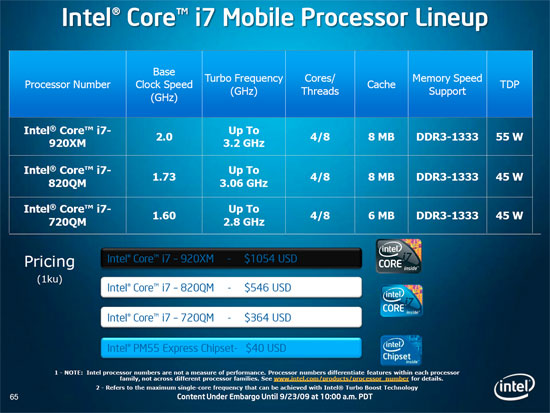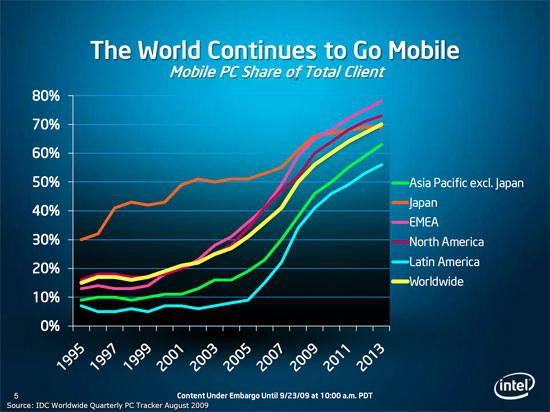Mobile Core i7 920XM, Clarksfield: Nehalem on-the-go
by Jarred Walton on September 23, 2009 10:00 AM EST- Posted in
- Laptops
Good morning and welcome to Fall 2009 IDF week! As usual, Intel has a ton of stuff to discuss at the Intel Developers' Forum (IDF). Most of the truly exciting stuff shows up first on the desktop - things like Larrabee and Sandy Bridge. Those of us who dwell more in the mobile market tend to get leftovers, but sometimes things taste better after they've had some time to age properly.

Not quite one year since the official launch of Nehalem for desktops and servers, Core i7 is officially making its way to notebooks. The processor is called Clarksfield, but it's essentially a mobile variant of Lynnfield. If you haven't read anything about Lynnfield, you might want to start with our thorough look at the desktop CPUs. Of course, there are some differences between Clarksfield and Lynnfield. Lynnfield processors use LGA-1156 for example, while the mobile Clarksfield uses a smaller 989-pin socket. Clarksfield also comes with new model numbers, naturally.
 |
Initially, Clarksfield is launching in three variants: i7-920XM, i7-820QM, and i7-720QM. The i7-920XM is an Extreme Edition processor, designed to replace the Core 2 Extreme QX9300. Like all Extreme processors, the i7-920XM carries a price tag of around $1000. If you want the latest and greatest, it's going to cost you. The i7-820QM drops performance slightly and cuts the price in half, with the i7-720QM as the "affordable" alternative. Unlike Lynnfield, all of the current Clarksfield parts have Hyper-Threading enabled. The Turbo modes are also aggressive on all of the models, but multi-core performance will definitely favor the i7-920XM.
| Codename | Market | Cores | Manufacturing Process |
| Bloomfield | Desktop | 4 | 45nm |
| Lynnfield | Desktop | 4 | 45nm |
| Clarkdale | Desktop | 2 | 32nm |
| Clarksfield | Mobile | 4 | 45nm |
| Arrandale | Mobile | 2 | 32nm |
One of the interesting presentation points from Intel concerns the question of why Clarksfield is important - after all, don't most people just use a desktop anyway? Intel provided the following slide:

There will always be a case for using desktops (and servers, workstations, etc.), but there's a growing trend in the world to move towards laptops. The gap between desktops and laptops has always been rather large, and honestly it still is. The fastest laptops currently available are about equal to what you could get on the desktop at least two years ago, give or take. Getting mobile i7 CPUs at least narrows the gap somewhat. Comparing Clarksfield and Lynnfield, maximum base clock speeds favor desktops by just under 50% while Turbo speeds for a single core bring Clarksfield within 13% of Lynnfield. While that's nice, it doesn't change the fact that desktop GPUs are still a couple generations ahead of the mobile parts.
Anyway, we are here to talk about Clarksfield today. This is a first look as we are still performing additional tests - yes, we have a Clarksfield notebook - but we will follow up with a complete review of the highest performing notebook solutions. For now, let's quickly go over the Clarksfield basics, look at some of the material from Intel, and compare performance in a few benchmarks.










63 Comments
View All Comments
strikeback03 - Wednesday, September 23, 2009 - link
So when are we going to see Arrandale? At these prices not so interested in Clarksfield.strikeback03 - Wednesday, September 23, 2009 - link
Also, probably Dragon error:If you're after optimal gaming performance, obviously just kidding, the fastest CPU or the fastest GPU alone won't cut it in every situation.
bottom of page 7.
JarredWalton - Wednesday, September 23, 2009 - link
I have no idea what I was even trying to say on that one. Hmmm.... Dragon at 8AM after working for 20 hours straight is NOT my friend! :-) Oh, wait: "just getting" without the comma should work.As for Arrandale, it's due out in Q1 2010, so not too far off. 32nm and dual-core + Hyper-Threading should be very compelling I think.
strikeback03 - Thursday, September 24, 2009 - link
yeah, just getting is what I assumed it was.So no Arrandale before Christmas? That's too bad.
TA152H - Wednesday, September 23, 2009 - link
Finally a review conclusion I can agree with.Dual core with hyperthreading should be better. I also don't think laptops will replace desktops for gaming. Is Intel crazy? That's just such a strange prediction, I don't know why they would think it's even remotely possible.
I think they should have waited for 32nm before releasing a Nehalem for mobile. Really, they have no competition from AMD worth speaking about, and 32nm could have been done right - with an integrated IGP if desired, and low enough power use that it's not one hour and out.
A micro-ATX setup with a handle, a Bloomfield and a real video card would probably be better for the vast majority of gamers than this one. You don't get true portability, but with only one hour of life, you don't really get it with this either.
The gloom and doom for desktops is always overstated. For one, laptops are really only comfortable for women and weak, pencil-necked men. If you have any size, the keyboard is a nightmare, and none come with the natural keyboard which men's shoulder width really begs for.
On top of this, mouse movement is a pain in the neck with that replacement. A mouse is just more comfortable. Then you have to worry about power, which kind of ruins a lot of the fun with computers - just kind of doing what you feel like and relaxing. Who wants to worry about power? Then, you're limited by screens. Of course, you can dock these things, and use them as desktops, in which case they only have disadvantages (although not as many) in this role, and no advantages.
So, I think desktops will always be around, and always be the preferred tool even if you have both.
I think one reason laptops sell pretty well is, ironically, because they are unreliable, and need replacement much more often. They are also more difficult to upgrade, also necessitating replacement rather than upgrade. So, the reasons aren't all good.
Penti - Saturday, September 26, 2009 - link
To be fair it's a desktop replacement cpu, like their many released before. Yes it will replace desktops for gaming but only for some. DTR cpus are also used for high-end mobile workstations. It's not for everybody get your grip together. They don't do everything because competition from AMD.goinginstyle - Wednesday, September 23, 2009 - link
The cut and paste king is at it again."A micro-ATX setup with a handle, a Bloomfield and a real video card would probably be better for the vast majority of gamers than this one. "
You have to be kidding, Lynnfield offers far superior power management and consumption plus better overall performance than Bloomfield. Something you would actually want in a micro-ATX setup, instead of a heat generator like Bloomfield. Even the Phenom/Athlon II would make for a better micro-ATX gaming platform than the energy sucking Bloomfield.
Before you get on your high horse about Bloomfield and overclocking, it's not going to make any difference in a micro-ATX system compared to Lynnfield, except to make the temperatures unbearable.
How is that next cut and paste article coming along for Toms? Are you going to do the history of lawnmowers on this one?
TA152H - Wednesday, September 23, 2009 - link
Dude, are you gay or something? What is your obsession with me?Wouldn't your current boyfriend be upset if he saw your obsession.
Micro-Atx would, naturally, be plugged in. What kind of an idiot are you? Battery life wouldn't matter in this context. The micro-ATX would be for easy movement from one place to another. Some of them are really small, light (so even you could move it), and easily transported. I wasn't implying you'd want to use it from a battery.
Didn't you understand that within the context? Clearly, you're a moron. And a gay, obsessive one. Get a life. You need attention, clearly, but not from me. Find someone else.
goinginstyle - Wednesday, September 23, 2009 - link
What is your obsession with posting negative comments to every article at AT? They have proven you wrong every step of the way. Why they even wasted their time is beyond me but I have to hand it to them for even paying attention to you.You obviously do not make these sames posts at Toms? I just read through the comments on the last six or seven articles. Especially the cpu related ones and you did not make a single comment even though their conclusion, test methods, and information is nearly the same at ATs when comparing Lynnfield vs Bloomfield. Why is that?
You brought up the Bloomfield micro-ATX setup and I was just replying to one not so bright idea of yours about Bloomfield once again being superior. The last thing you want in a micro-ATX system you will be lugging around to LAN parties is a Bloomfield cpu and X58 chipset. Heat is thy enemy and this platform has ridiculous power consumption compared to Lynnfield or Phenom II. Considering the alternatives available I would say Bloomfield should be one of the last ones to suggest.
TA152H - Wednesday, September 23, 2009 - link
You're really not that stupid, are you?My post wasn't negative. I agreed with the author. I don't agree with Intel, and neither did he. What is your problem, besides liking me?
They didn't prove anything, at all. You're just too stupid to see through the weird benchmarking. Maybe I stopped reading before they posted their 'proof'. But, really, Anand's apple to apple benches proved my point. In their first article, they were saying they were the same or better. Then, all of the sudden, the Bloomfield is 3.5% faster, normalized! Sometimes almost 10%, on real world benchmarks. Fancy that! Although, this time they screwed up by making the Bloomfield uncore faster, so it's not 100% accurate.
Tom's also showed a lot of advantages of the Bloomfield. This site just rubbed me the wrong way because they were doing whatever they could to make the Lynnfield look better than it really is. Is 3% a big deal? Who knows? Maybe it is, maybe it isn't. That's a matter of perspective. But, when I see 0%, or -1%, and I know it's just not so, that's where someone has to say something. If they were arguing 3% isn't so important, then, so be it. But, show the 3%, instead of hiding it behind bogus setups that hide it.
You wouldn't understand because you're simple. But, life isn't simple. Very few things are good or bad, completely.
By the way, why would power matter more for micro-ATX than for anything else? The Bloomfield is king of the hill. I'm not crazy about the power use, really, I'm not, but, for a gaming platform, I'd want the best. I'd put up with the additional power use.
For a computer I'd put in the kitchen and would only surf on, I'd probably be much more inclined to look at power. Of course, even then I wouldn't consider the Lynnfield. I'd get a Core 2 or Pentium, a G45, and get all the performance I needed.
Also, you probably didn't notice, because Gary hid it, that the voltage needed to overclock the Lynnfield was considerably higher than the Bloomfield. That makes me a little nervous. But, still, I agree completely the x58 needs to go on a diet. I wish Intel would move it down to 45nm. It's a high end platform, it deserves it.
So, it's not the size, it's the application. Hmmmm, that could have a different context, but, remember we're talking about computers here.